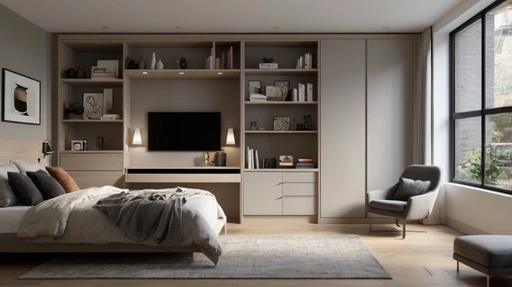The Complete Guide to Choosing, Installing, and Maximizing a Murphy Bed
Introduction
- What is a Murphy bed and why it’s a great space-saving solution for homes.
- Overview of the article: benefits, types, installation tips, and creative ways to incorporate Murphy beds into different spaces.
Understanding Murphy Beds
- Definition: What a Murphy bed is and its origin.
- History: The evolution of the Murphy bed from its invention to modern designs.
- Benefits:
- Space-saving benefits for small apartments, studios, guest rooms, and home offices.
- Versatility and functionality: dual-purpose rooms.
- Easy setup and use for guests or multi-functional rooms.
Types of Murphy Beds
- Standard Murphy Bed:
- The traditional fold-down bed against the wall.
- Available in twin, full, queen, and king sizes.
- Options for manual or hydraulic/electric mechanisms for easy lifting.
- Panel Murphy Beds:
- The bed folds behind a cabinet or closet-style door.
- The cabinet can be customized with shelves, drawers, or decorative panels.
- Desk Murphy Beds:
- Integrated with a desk for a multi-functional workspace and sleeping area.
- Ideal for home offices and small apartments.
- Bookcase Murphy Beds:
- The bed folds out from a bookcase or shelving unit.
- Provides extra storage space for books and decor when not in use.
- Corner Murphy Beds:
- Designed to fit into a corner, making use of tight spaces.
- Ideal for small bedrooms or guest rooms.
- Outdoor Murphy Beds:
- For camping or RVs, foldable into a compact and portable size.
Choosing the Right Murphy Bed
- Size:
- Determining the right bed size based on room dimensions and intended use.
- Mechanism:
- Choosing between manual or hydraulic/electric mechanisms.
- Style and Finish:
- Matching the bed to your existing decor and the room’s aesthetic.
- Mattress:
- Selecting the right mattress type for comfort and support (memory foam, innerspring, etc.).
- Budget:
- Considering costs for the bed itself, installation, and any customization.
Installation of a Murphy Bed
- DIY vs. Professional Installation:
- Pros and cons of installing a Murphy bed yourself versus hiring a professional.
- Preparation:
- Measuring the space accurately.
- Clearing out the area for installation.
- Steps for DIY Installation:
- Tools needed: screwdrivers, level, drills, and a friend for help.
- Instructions for assembling and mounting the bed.
- Professional Installation:
- What to expect if hiring a professional installer.
- The benefits of professional installation, especially for complex configurations.
Maximizing the Use of a Murphy Bed
- In Small Spaces:
- Incorporating the bed into apartments, studios, or lofts.
- Creative furniture arrangements for optimal space use.
- Multi-functional Rooms:
- Combining a Murphy bed with home offices, guest rooms, or playrooms.
- Tips for creating a seamless transition between the day and night use.
- Storage Solutions:
- Using the area around the bed for shelves, drawers, and storage units.
- Ideas for integrating the bed with existing furniture to maximize storage space.
Maintenance Tips for Murphy Beds
- Regular Maintenance:
- Keeping the mechanisms clean and lubricated.
- Checking for wear and tear on the bed and components.
- Safety Checks:
- Ensuring the bed folds and unfolds smoothly.
- Securing the bed to prevent accidents.
- Cleaning:
- Wiping down the bed frame and the mattress.
- Vacuuming around and under the bed to keep dust away.
Conclusion
- The versatility and value of a Murphy bed in modern homes.
- Final tips for choosing, installing, and maintaining a Murphy bed for long-term functionality.
- Encouragement to consider a Murphy bed as a creative solution for maximizing space in your home.
Murphy Bed Gallery





